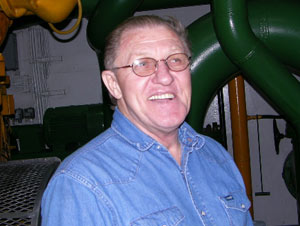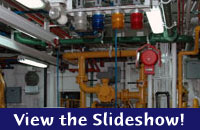Interviews: Paul Waters, Chief Engineer on the L. M. Gould

Chief Engineer Paul Waters explains the color-coded fuel and seawater lines in the engine room of the Gould. (Photo by Kate Madin, WHOI)
A ship looks deceptively simple. It’s easy to think of it as a hull, a deck, and an engine to power it. To function, though, a ship depends on the smooth interaction of many systems. The chief engineer is responsible for seeing that all the ship’s physical, mechanical, and electrical systems work, and for maintaining “life support” systems—fuel, fresh and salt water, plumbing, wiring, air filtration and circulation, and more. The Gould’s Chief Engineer Paul Waters, from North Carolina, loves his work, and intimately knows all the ship’s systems. This interview took place during a tour through the engine room.
 The first thing I noticed about the engine room is how clean and bright it is. Second Mate David Morse tells people “this is the cleanest engine room I’ve ever seen, on any ship, anywhere.” How can you keep it so clean?
The engine room is noisy, but it’s clean. We have really good oilers (men who work in the engine room). They don’t mind working here, cleaning, because it’s already clean. We’re constantly cleaning, every single day.
The room is a bright white, but almost everything in the room is painted with cheerful primary colors. There are pipes in different colors running all over the walls and ceiling. Why is that?
Everything’s color-coded so we automatically know what is in what pipe. The blue pipes are potable (drinkable) water. Green is seawater lines. Brown is the sewage line. Those black ones are drain lines–dirty oil is black. The orange ones are hydraulic lines; there’s hydraulic fluid in all of them. Red—that’s the fire system—the CO2 gas extinguishers. All the yellow means fuel lines, and the engines are yellow. Light green is the compressed air system.
What are the clear and colored glass cylinders hanging up in back of the room?
Those are lights—they’re the alarms. You can’t hear the sirens down here, so they flash to alert you. The red is fire, and amber is the control room. But the clear one means get out—you have ten seconds to get out of the area and go above to your muster station (in case of an ‘abandon ship’ order.)
Besides the control room, there are about five rooms that make the “engine room.” What are some of the systems you deal with down here?
We have generators, and the two main propulsion engines, painted yellow. There are 49 pumps on the ship, of seven different types—they all have to be maintained regularly. We have 700 miles of electrical wire, 42 filters in the fresh water purification system, and seven welding stations spaced around the engine rooms. In the workshop: lathes, worktable, drill press—so we can make just about anything we need. We have storage rooms full of spare parts for every part on the ship.
How did you become a chief engineer?
You work your way up. You start as an oiler for a few years. It takes lots of years to gain the knowledge and experience you need to handle a ship like this.
What about the control room, with the lighted console?
Oh, that’s for paperwork! That’s where I do the log book. When I’m not doing that, I’m down here all of the time, looking, checking—looking for any problems, or leaks. I can tell by listening if there’s something wrong, if there’s something different about the engine.
(Through a tunnel-like corridor is the room where the ship’s two rudders terminate inside the ship. The sides of the room reflect the curve of the hull, and it seems very close to the cold water.)
It’s white and clean, in here, too.
Lots of ships you see are rusted out down here in this room. It’ll be gray paint, and everything dirty, because no one takes care of it. This ship is different. We’re always down here, checking every part of the systems. No one has to tell us to. We replace things before they cause a problem.
(He pointed to a massive light green chunk of metal with a central hole through it, and corrosion in the hole.)
That’s a check valve for the front water cooling system. No one told us to look at it. No one knew there was a problem; there were no symptoms. But we changed it out. We want to catch things before they happen.
Tell me about your own history, how you came to be here
Home is in North Carolina. but I’ve always worked “out”—outside the region. I’ve worked in Antarctica, Louisiana, logging in Oregon—but I always go home to the North Carolina mountains. I once went from here to Southeast Asia working in the engine room of a ship–it was so hot! I lost about 20 pounds, all in sweat. Engine rooms are hot places, but this one has cool air circulating from outside, so the heat isn’t a problem.
Do you like it here?
Oh, I love it here. The Antarctic—you see this beautiful coastline. You get the chance to meet scientists. And we try to make it nice for you on the ship. If anything’s wrong in your room or lab, let us know, and we’ll get it fixed.
Paul has been doing this ten months a year for twelve years. He promised he’d ease off in the next few years and go to sea less. But he loves his work.
|


